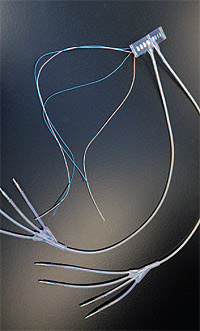Advanced Platform Technology Center
Matthew Schiefer, PhD
 Dr. Schiefer is a researcher at the Louis Stokes Cleveland Veterans Affairs Medical Center (LSCVAMC) and an instructor at Case Western Reserve University. His research is in the field of Neural Engineering, a sub-field of Biomedical Engineering, focusing on understanding the peripheral nerve response to eating and the development and assessment of stimulus waveforms applied to the vagal and splanchnic nerves to produce a sense of satiety and reduce obesity.
Dr. Schiefer is a researcher at the Louis Stokes Cleveland Veterans Affairs Medical Center (LSCVAMC) and an instructor at Case Western Reserve University. His research is in the field of Neural Engineering, a sub-field of Biomedical Engineering, focusing on understanding the peripheral nerve response to eating and the development and assessment of stimulus waveforms applied to the vagal and splanchnic nerves to produce a sense of satiety and reduce obesity.
Dr. Schiefer is a Co-Investigator with:
Dr. Kingman Strohl, focusing on hypoglossal nerve stimulation for treating obstructive sleep apnea (OSA)
Drs. Dustin Tyler and Jonathan Miller, focusing on spinal cord stimulation to reduce chronic pain
Dr. Frank Jacono, focusing on vagal nerve stimulation to treat sepsis
In the past, Dr. Schiefer focused on designing neural interfaces for peripheral neuroprostheses through computer simulations and acute (short-term) evaluations in humans. His most recent project investigated the restoration of sensation in upper extremity amputees and the functional improvement that could be provided through restored sensation.
Photo: From the "Model-driven Design of Optimal Electrodes and Stimulation" project. APT Center Investigators are applying finite element method computer models to simulate the complicated spread of electric current throughout realistic, histologically-derived, 3D representations of human nerves. Biomechanical models are also being combined with these neural models to predict the functional outcomes that can be expected at the muscle or joint level. Using statistical methods, the optimal size, shape, number and distribution of contacts and within a nerve cuff electrode can be determined. These computer simulations have allowed the cuff to be appropriately designed for each target nerve, balancing the engineering and manufacturing constraints with the clinical requirements. Dr. Schiefer is a principal investigator on this project.




















